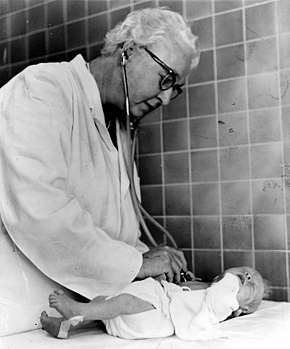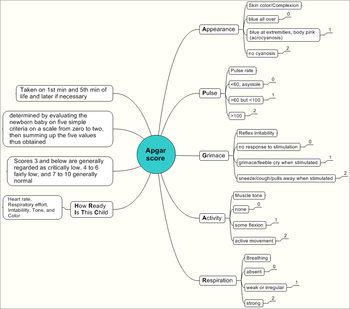Apgar score
The Apgar score is a method to quickly summarize the health of newborn children against infant mortality.[1][2] Virginia Apgar, an anesthesiologist at New York–Presbyterian Hospital, developed the score in 1952 to quantify the effects of obstetric anesthesia on babies.[3]
| Apgar score | |
|---|---|
 Virginia Apgar, creator of the Apgar score | |
| Purpose | method to summarize newborn's health |
The Apgar score is determined by evaluating the newborn baby on five simple criteria on a scale from zero to two, then summing up the five values thus obtained. The resulting score ranges from zero to 10. The five criteria are summarized using words chosen to form a backronym (Appearance, Pulse, Grimace, Activity, Respiration).
Criteria
| Score of 0 | Score of 1 | Score of 2 | Component of backronym | |
|---|---|---|---|---|
| Skin color | blue or pale all over | blue at extremities, body pink (acrocyanosis) | no cyanosis body and extremities pink |
Appearance |
| Pulse rate | absent | < 100 beats per minute | ≥ 100 beats per minute | Pulse |
| Reflex irritability grimace | no response to stimulation | grimace on suction or aggressive stimulation | cry on stimulation | Grimace |
| Muscle Tone | none | some flexion | flexed arms and legs that resist extension | Activity |
| Respiratory effort | absent | weak, irregular, gasping | strong, robust cry | Respiration |
Interpretation of scores

The test is generally done at 1 and 5 minutes after birth and may be repeated later if the score is and remains low. Scores of 7 and above are generally normal; 4 to 6, fairly low; and 3 and below are generally regarded as critically low and cause for immediate resuscitative efforts.[4]
A low score on the 1-minute mark may show that the neonate requires medical attention,[5] but does not necessarily indicate a long-term problem, particularly if the score improves at the 5-minute mark. An Apgar score that remains below 3 at later times, such as 10, 15, or 30 minutes, may indicate longer-term neurological damage, including hypoxic ischaemic encephalopathy and seizure[6]. However, the Apgar test's purpose is to determine quickly whether or not a newborn needs immediate medical care. It is not designed to predict long-term health issues.[1]
A score of 10 is uncommon, due to the prevalence of transient cyanosis, and does not substantially differ from a score of 9. Transient cyanosis is common, particularly in babies born at high altitude. A study carried out in Peru, that compared babies born near sea level with babies born at very high altitude (4340 m or 14,138 ft), found a significant average difference in the first Apgar score but not the second. Oxygen saturation also was lower at high altitude.[7]
Implementation of scores
In cases where a newborn needs resuscitation, it should be initiated before the Apgar score is assigned at the 1-minute mark. Therefore, the Apgar score is not used to determine if initial resuscitation is needed, rather it is used to determine if resuscitation efforts should be continued. Variation between the 1-minute and 5-minute Apgar scores can be used to assess an infant's response to resuscitation. If the score is below 7 at the 5-minute mark, the Neonatal Resuscitation Program guidelines specify that the infant's Apgar score should be reassessed at 5-minute intervals for up to 20 minutes.[3]
A systematic review that analyzed the relationship between umbilical cord pH and neonatal outcomes found that low cord pH is strongly correlated with mortality, morbidity and cerebral palsy in childhood.[8] To reduce the risk of negative outcomes, it is recommended to obtain a sample of the umbilical artery blood gas when a newborn has an Apgar score of 5 or less at the 5-minute mark.[3]
Limitations
There are numerous factors that contribute to the Apgar Score, several of which are subjective. Examples of subjective factors include but are not limited to color, tone, and reflex irritability. Preterm infants may receive a lower score in these categories due to lack of maturity rather than asphyxia. Other factors that may contribute to variability among infants are birth defects, sedation of the mother during labor, gestational age or trauma. Inappropriately using the Apgar Score has led to errors in diagnosing asphyxia.[3]
Various studies have shown that the Apgar score has variability between individual medical providers. A study was done in which health care providers were assigned to give Apgar scores to a group of infants. [9]Results showed that health care provider had a consistency of 55% to 82% when it came to assigning scores when compared with one another.[9][10]
Acronym
Some ten years after initial publication, a backronym for APGAR was coined in the United States as a mnemonic learning aid: Appearance (skin color), Pulse (heart rate), Grimace (reflex irritability), Activity (muscle tone), and Respiration.
- Spanish: Apariencia, Pulso, Gesticulación, Actividad, Respiración;
- Portuguese: Aparência, Pulso, Gesticulação, Atividade, Respiração;
- French: Apparence, Pouls, Grimace, Activité, Respiration;
- German: Atmung, Puls, Grundtonus, Aussehen, Reflexe, representing the same tests but in a different order (respiration, pulse, muscle tone, appearance, reflex).
- Czech: Adaptace kůže, Pulz, Grimasy, Aktivita svalů, Respirace;[11]
Another eponymous backronym from Virginia Apgar's name is American Pediatric Gross Assessment Record.
Another mnemonic for the test is “How Ready Is This Child?”, which summarizes the test criteria as Heart rate, Respiratory effort, Irritability, Tone, and Color.[12]
See also
References
- Apgar V (1953). "A proposal for a new method of evaluation of the newborn infant" (PDF). Current Researches in Anesthesia & Analgesia. 32 (4): 260–7. doi:10.1213/00000539-195301000-00041. PMID 13083014.
- Finster M, Wood M (April 2005). "The Apgar score has survived the test of time". Anesthesiology. 102 (4): 855–7. doi:10.1097/00000542-200504000-00022. PMID 15791116. S2CID 19697516.
- "The Apgar Score - ACOG". www.acog.org. Retrieved 2019-08-01.
- Holton T. "What Are APGAR Scores, And Why Are They Important?". www.holtonlaw.com.
- Casey BM, McIntire DD, Leveno KJ (February 2001). "The continuing value of the Apgar score for the assessment of newborn infants". The New England Journal of Medicine. 344 (7): 467–71. doi:10.1056/NEJM200102153440701. PMID 11172187.
- https://www.ncbi.nlm.nih.gov/books/NBK328263/
- Gonzales GF, Salirrosas A (September 2005). "Arterial oxygen saturation in healthy newborns delivered at term in Cerro de Pasco (4340 m) and Lima (150 m)". Reproductive Biology and Endocrinology. 3: 46. doi:10.1186/1477-7827-3-46. PMC 1215518. PMID 16156890.
- Malin GL, Morris RK, Khan KS (May 2010). "Strength of association between umbilical cord pH and perinatal and long term outcomes: systematic review and meta-analysis". BMJ. 340 (may13 1): c1471. doi:10.1136/bmj.c1471. PMC 2869402. PMID 20466789.
- Montgomery, Kristen S. (2000). "Apgar Scores: Examining the Long-term Significance". The Journal of Perinatal Education. 9 (3): 5–9. doi:10.1624/105812400X87716. ISSN 1058-1243. PMC 1595023. PMID 17273212.
- Livingston, Jacquelynn (1990-11-01). "Interrater reliability of the apgar score in term and premature infants". Applied Nursing Research. 3 (4): 164–165. doi:10.1016/S0897-1897(05)80139-9. ISSN 0897-1897. PMID 2252404.
- "Co je to APGAR skóre a kdo ho vymyslel?". www.maminka.cz (in Czech). Retrieved 2020-01-12.
- Klostranec JM, Hong J, Raghuran K (2012). The Essential Med Notes for Medical Students. Toronto, ON: University of Toronto Press.
Further reading
- Apgar V (August 1966). "The newborn (Apgar) scoring system. Reflections and advice" (PDF). Pediatric Clinics of North America. 13 (3): 645–50. doi:10.1016/S0031-3955(16)31874-0. PMID 5946299. (Retrieved from Profiles in Medicine-The Virginia Apgar Papers)